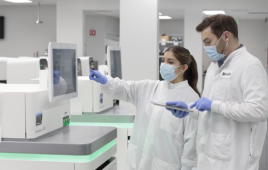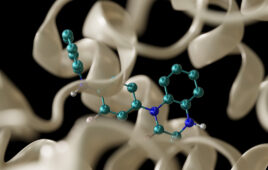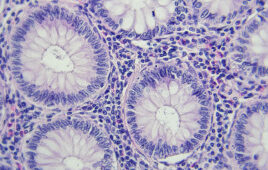
Chromosome loops (rainbow colors) wind around the helical scaffold (red rings), creating a tightly coiled bundle. Photo: HHMI
Genome folding now has a playbook.
A new step-by-step account spells out in minute-time resolution how cells rapidly pack long tangles of chromosomes into the tiny, tightly wound bundles needed for cell division. Cells reel chromosomes into loops, and then wind the loops into spiral staircase structures, Howard Hughes Medical Institute researchers report January 18, 2018, in the journal Science.
“This is the most fundamental process of genetics,” says study coauthor and Howard Hughes Medical Institute (HHMI) Investigator Job Dekker. If packing goes awry, chromosomes can break and end up in the wrong place – a hallmark of cancer.
The new work solves a biological mystery that dates back more than a century, Dekker says, when scientists first spied chromosomes under the microscope.
Most of the time, our cells’ chromosomes are strung out in the nucleus like an unraveled skein of yarn. The diffuse strands look like little blobs, says Dekker, a biochemist at the University of Massachusetts Medical School. But during mitosis, when our cells prepare to split in two and hand over genetic material to daughter cells, chromosomes coil up, cramming roughly six feet of DNA into microscopic packages. Cells can easily deliver these condensed, X-shaped nuggets to their daughters, Dekker says. Then, chromosomes crumple apart again, back into blobs.
Scientists had previously figured out how cells structured these loose, diffuse chromosomes. And four years ago, Dekker and colleagues reported the structure of tightly packed chromosomes – an array of consecutive loops. But, he says, the big question was how cells transitioned from one state to the other and back again – and so quickly, too. “The whole process happens in 10 to 15 minutes,” he says. “It’s unbelievable.”
It has also been a matter of fierce debate. Some researchers believed that cells twisted their chromosomes into helices, while others thought cells simply stuck with the loops.
Dekker, along with William Earnshaw of the University of Edinburgh’s Wellcome Trust Centre for Cell Biology, Leonid Mirny of the Massachusetts Institute of Technology, and colleagues used a genetic trick to synchronize chicken cells in the lab so that they all began packing their chromosomes simultaneously. Then the scientists took snapshots of the chromosomes at different time points.
Within minutes, the researchers could see Jell-O-like globs of DNA arrange into ropey rods.
Next, the team cemented the chromosomes in place, affixing together all the spots where individual strands touched. Analyzing the DNA sequence of these junctions gave the team clues about the chromosomes’ architecture. “If you know which part of the rope is next to which, you can reconstruct its 3-D structure,” Dekker says.
Those data, along with computer simulations of the folding process, let the researchers test predictions about how chromosomes transition from blob to rod. “Because the structures are so totally different, you think, ‘Oh my, that must be a highly complicated and difficult process,’” Dekker says.
But actually, it all happens in a few simple steps, the team discovered. Small, ring-like protein motors called condensins push yards of chromosomes through the rings, forming loops. Condensin II weaves the chromosomes into a chain of wide loops, and then another protein, condensin I, splits the big loops into smaller ones. Then the loops, hundreds per chromosome, twist around like a spiral staircase.
Such an elegant, efficient packing strategy may explain how cells can so reliably bundle their chromosomes over and over again, every time the cell divides, Dekker says.
The new work promises to unify two formerly conflicting views of the mitotic chromosome. Chromosomes can be arranged in an array of loops, but they can also be helical, Dekker says. “I find this extremely satisfying,” he says. “I always aim for consilience. If you’re confronted with datasets that supposedly tell you two different things, can you find a way for them both to be right?”
Filed Under: Genomics/Proteomics



